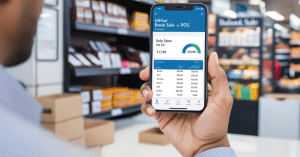Introduction
Opening a grocery store in Pakistan is an exciting venture with immense potential. However, it’s also one that comes with several challenges, especially for first-time business owners. From managing the store layout to ensuring the right stock levels and tracking your finances, there are numerous moving parts to consider. Success in the grocery business requires careful planning, organization, and a robust system to keep everything in check.
In this blog, we’ll guide you through 5 essential steps to kickstart your grocery store business. These steps will provide a clear roadmap to establish your store, attract customers, and begin managing operations effectively. Additionally, we’ll show you how Udhaar Book can help streamline the entire process by digitizing your grocery store functions for optimal efficiency.
Step 1: Plan Your Store Layout and Product Selection
The foundation of a successful grocery store starts with how you organize your space and the products you offer.
-
Product Selection: You need to decide which products will be the focus of your store. Will you offer everyday essentials, specialty goods, or perhaps organic and imported items?
-
Store Layout: The way you lay out your store is crucial to driving sales. Keep high-demand products at eye level and organize aisles in a way that makes it easy for customers to navigate the store.
-
Store Size and Sections: Consider the size of your store and divide it into logical sections for fresh produce, canned goods, dairy, snacks, and so on. This will keep the shopping experience smooth and hassle-free for your customers.
Step 2: Set Up a Reliable Financial System
Financial management is a critical element in any business, and the grocery business is no exception. Without the proper systems in place, you risk overspending, undercharging, and missing out on profits.
-
Track Expenses: Make sure you’re recording all expenses including rent, utilities, stock purchases, and staff wages.
-
Monitor Cash Flow: Understand where your money is coming from (sales) and where it’s going (expenses).
-
Set Pricing: Pricing is key to maintaining a profitable business. Ensure your prices cover your costs while being competitive in your market.
Step 3: Build Strong Supplier Relationships
Reliable suppliers are essential for maintaining stock and ensuring that your grocery store is well-stocked with high-demand products.
-
Negotiate Prices: Building strong relationships with suppliers helps you negotiate better prices for your products, which in turn boosts your profit margins.
-
Timely Deliveries: Having suppliers who can deliver on time ensures that your inventory remains well-stocked without any interruptions.
-
Quality Assurance: Work with suppliers who offer consistent quality, especially for perishable items like fruits, vegetables, and dairy products.
Step 4: Implement Effective Inventory Management
Efficient inventory management is the backbone of a successful grocery store.
-
Track Inventory: Keep a close eye on your stock to avoid both overstocking (which increases storage costs) and understocking (which can lead to missed sales).
-
Stock Rotation: For perishable goods, always ensure a first in, first out (FIFO) system so that older stock is sold first to reduce wastage.
-
Reorder System: Keep track of inventory levels in real-time and establish an automatic reordering system to ensure you never run out of best-sellers.
Step 5: Market Your Store to Attract Customers
Marketing is essential to build awareness and draw customers to your store.
-
Social Media Presence: Use platforms like Facebook, Instagram, and WhatsApp to post promotions, highlight sales, and showcase new products.
-
Loyalty Programs: Offer promotions or discount programs for regular customers to encourage repeat visits.
-
In-Store Promotions: Place discount signs in-store for high-demand items, and don’t forget to use flyers or local advertising to spread the word in your neighborhood.
How Udhaar Book Helps Digitize Your Grocery Store Operations
Managing a grocery store involves numerous tasks, and keeping everything organized can be overwhelming without the right tools. Udhaar Book is designed to help store owners streamline operations and make business management more efficient. Here’s how Udhaar Book can digitize your grocery store functions:
-
Inventory Management: With Udhaar Book’s Stock Book feature, you can track your stock in real-time, organize products by category, and get low-stock alerts so you never run out of high-demand items.
-
Financial Management: Record all sales, expenses, and credits using the Digital Khata feature. Udhaar Book also helps you generate instant financial reports to track your profits, losses, and overall performance.
-
Sales Tracking: Use Udhaar Book’s POS (Point of Sale) system to easily process transactions, apply discounts, and manage customer data, helping you stay on top of your sales and customer trends.
-
Credit Management: Track customer udhars (credits) and automatically send payment reminders to ensure timely payments and improved cash flow.
-
Business Analytics: Generate detailed sales reports to understand customer preferences, optimize pricing strategies, and make data-driven decisions that can help you increase profits.
Conclusion
Starting a grocery store in Pakistan is a rewarding but challenging endeavor. By following these 5 essential steps, you can create a solid foundation for your business. The key is to keep your operations efficient, your stock well-managed, and your finances organized. Udhaar Book is here to help you digitize every aspect of your grocery store, from inventory management to customer transactions, making business management much simpler and more profitable.
Ready to simplify your grocery store operations? Download Udhaar Book today and take the first step toward managing your business like a pro.
Learn more about Udhaar Book










